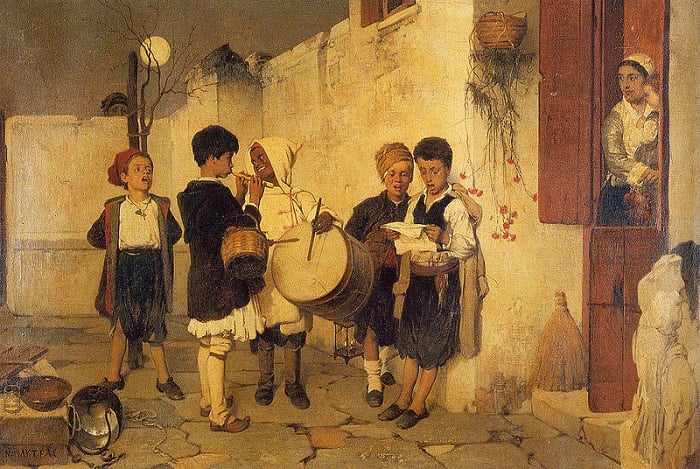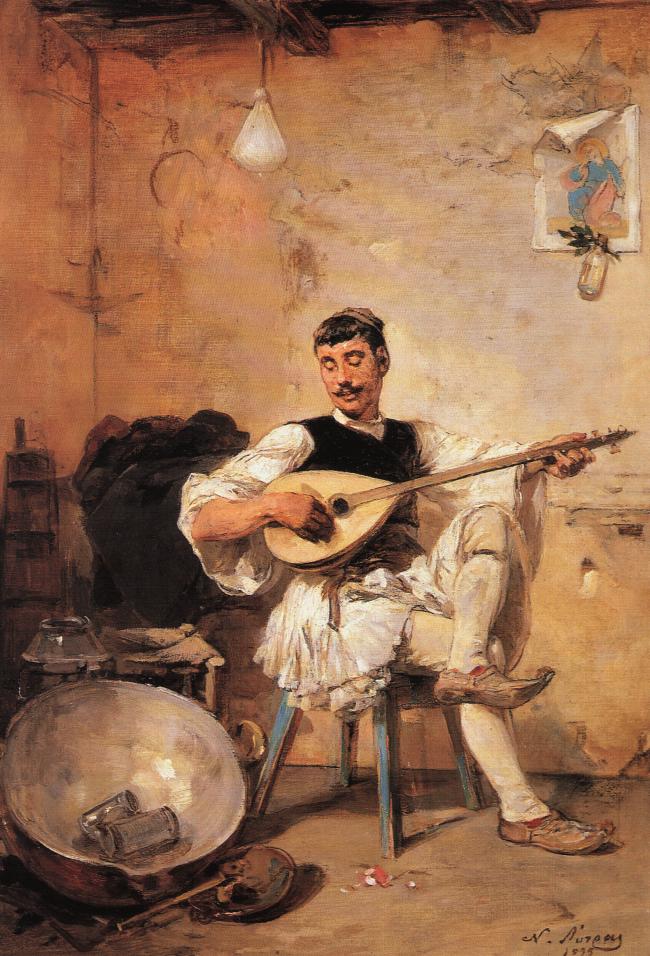
The beloved painting, The Carols (Greek: Τα Κάλαντα), created in 1872 by the Greek painter Nikiforos Lytras, is one of the most famous works in the history of modern Greek art. It is still admired today and is widely shared on social media during Christmas and New Year’s.
Under the soft, radiant light of a full moon, five children from different backgrounds and nationalities, dressed in the clothing of the era, play traditional Greek musical instruments and sing time-honored Christmas carols in the courtyard of a house.
The wife of the house stands with her toddler in the window, listening to the carols. Behind the wall, the viewer can spy the head of another child closely watching this beloved Greek Christmas tradition, perhaps not daring to take part.
The full moon and the flowers hanging from the pot on the wall give a warm and serene harmony to the whole picture, while the broom and the staked tree in the yard show the care taken by the poor household.
The carols painting includes an ancient Greek statue
The statue at the bottom of the painting illustrates not only the timeless unity of Greek culture but also the painter’s love for his father’s ancient profession of marble sculpting.

Lytras was the son of a popular marble sculptor. In 1850, at the age of eighteen years, he went to Athens to study in the School of Arts. After graduating in 1856, he began teaching an elementary course in writing.
In 1860 with a Greek government scholarship, he went to Munich to study in the Royal Academy of Fine Arts where, after some time, he was accepted into the classes of Karl von Piloty. In 1862 after King Otto was exiled, the scholarship was no longer available to Lytra so the expenses were undertaken by the ambassador of Greece in Vienna, Simon Sinas.
Following his return to Athens, Lytras became a professor at the Athens School of Fine Arts in the Department of Painting, and he taught until the time of his death for around thirty-eight years.
For four years, starting in 1873, he traveled to Smyrna and Asia Minor, Munich, and Egypt with Gyzis, producing several Orientalist works.

In 1879, he married Irene Kyriakidi, the daughter of a tradesman from Smyrna, and they had six children. His son, Nikolaos Lytras, followed in his footsteps and also studied at the Munich Academy of Fine Arts. He then went to the Athens School of Art.
Lytras, who is considered the patriarch of modern Greek painting, embraced the principles of Academic Realism, i.e., with paintings that depicted scenes, whether real or imaginary, of painstaking exactitude and treatment of color, along with portraying a narrative mood.
During the time Lytras was in Munich, he focused on historical painting, with subjects inspired by Greek mythology and history. Following his return to Greece, he began to paint portraits and scenes of everyday life.
During this period, the great Greek master wrote that “the painter should devote himself to genre painting, and to subjects that move, delight, and educate the people.”
Lytras died at the age of seventy-two in 1904 after a short illness that is believed to have been caused by the chemicals in his paints.
See all the latest news from Greece and the world at Greekreporter.com. Contact our newsroom to report an update or send your story, photos and videos. Follow GR on Google News and subscribe here to our daily email!



